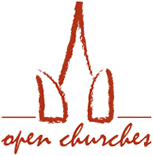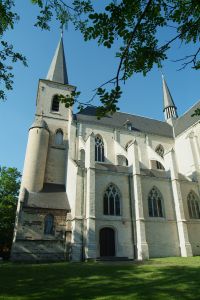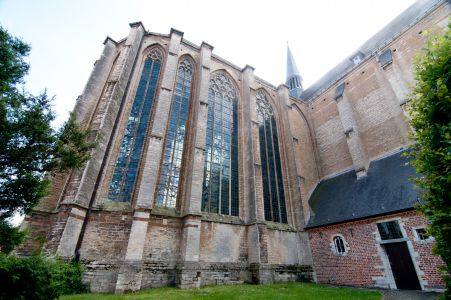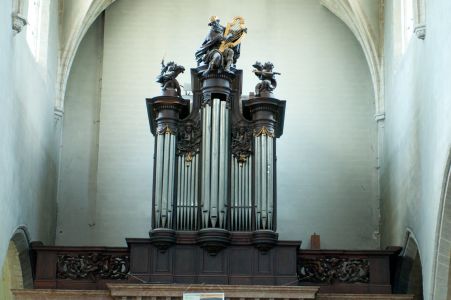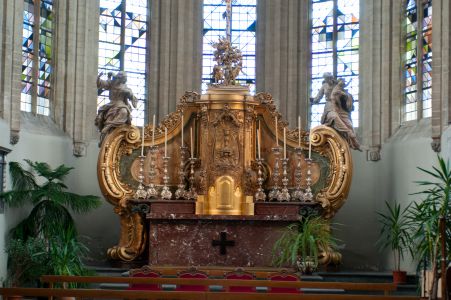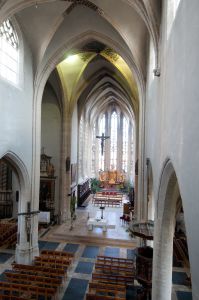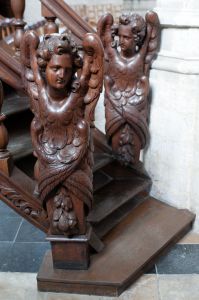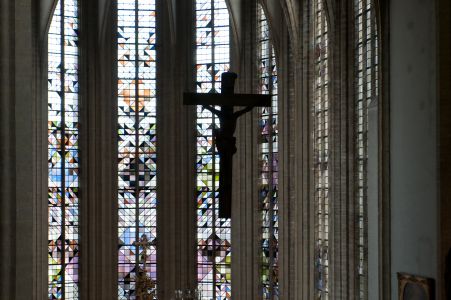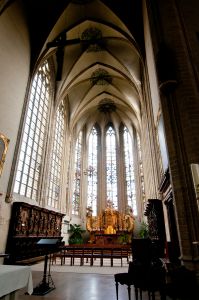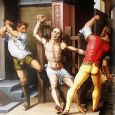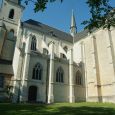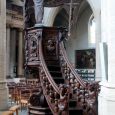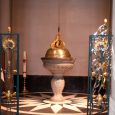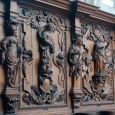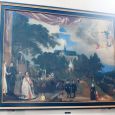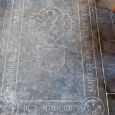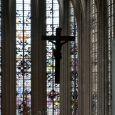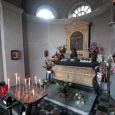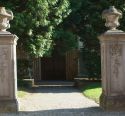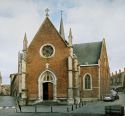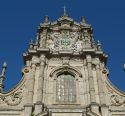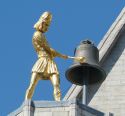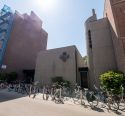The Holy Quintinus
Quintinus was the son of a Roman senator and was a legionary stationed in Amiens (Samarabriva) in Northern France. He was a Christian and he proclaimed his faith. During the great persecution of Christians under Emperor Diocletian in 287 Quintinus was captured, tortured, beheaded and thrown in the Somme († October 31). This saint of the people is called on for rheumatism, nerve and heart disease, dropsy, convulsions, growing pains, ulcers, tumours, whooping cough, whitlow on fingers and stomach complaints. Some fragments of murals (15th century) on the sidewalls of the presbytery were discovered during the restoration of the church (1967-1970). They depict, according to the ‘Roll of Saint Quentin’, scenes of the ‘vita’ of the saint.
Architecture
The construction of the church took place in several phases and started around 1440. The choir and the transepts are in the Brabant Gothic, while the nave and aisles are built in a simpler peasant Gothic.
Pulpit
The baroque pulpit in oak (second half of the 17th century) is decorated with busts of Christ, the four Evangelists and Saint Quentin.
Font
The baptismal font can be found in the baptistery under the tower, behind a wrought iron fence in Louis XV style (1765). It is a late Gothic stone font with inscriptions (1560) and a cover in chased copper with a counterweight (1779)
Choir stalls
In the baroque choir stalls (18th century) on the northern side one can see exalted female figures alternated with female herm images that depict the ‘virtues’. However, ‘Love’ and ‘Wisdom’ are missing. They were stolen in September 2002. On the southern side one can see exalted male figures alternated with male herm images that depict the ‘Apostles’ with their attributes. The Apostle ‘Paul’ was also stolen in 2002.
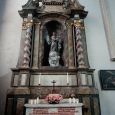
Side altars
An altar in honour of Our Lady can be found in the northern transept. It is decorated with a 17th century statue of ‘Our Lady of Peace and Sweet Accord?’ made by Artus Quellinus de Jonghe. A baroque altar dedicated to Saint Anna stands in the same transept. It is decorated with the painting “Saint Anna at Threes” by Gasper de Crayer (circa 1618) and depicts the Holy Anna, the Holy Virgin Mary and the child Jesus surround by five saints of the plague: Saint Christopher, Saint Roch, Saint Anthony Abbot, Saint Adrian and Saint Sebastian. The southern side altar is also decorated with a painting by Gaspar de Crayer: “The vision of Saint Teresa of Avila”. The baroque altar in the southern transept is decorated with an 18th century painting by Pieter Jozef Verhaghen called “The Martyrdom of Saint Quentin” and with a statue of Saint Quentin as a Roman soldier (17th century) by Artus Quellinus de Jonghe. A polychrome sculpture group depicts “The Three Holy Sisters”: Berthilia, Eutropia and Genoveva.
Paintings
The church still owns several paintings, including several works by the baroque painters Jan Jozef Verhaghen: “Ecce Homo” (1779), “The sacred countenance” (1778), “The mockery of Jesus” (1781) and Pieter Jozef Verhaghen: “Angel comforting Jesus in the olive garden” (1791), “Christ crowned with thorns” (1784), “The Flagellation of Christ” (1791). The painting “The Last Supper” is by the hand of the city painter of Leuven Jan Willems and dates back to the early Renaissance (1521). “The Procession to Basse-Wavre (1653, school of Brabant) is a unique time document of the last period of the plague of the Saint Quentin church. “The Adoration of the Shepherds” and “The Entombment” are both attributed to the Flemish school (17th century). “The Mystic Marriage of Saint Catharine” is an 18th century copy of a work that is also attributed to the Flemish school.
Tombstones
37 tombstones can be found in the church. The oldest grave is that of Leo van Lacousture (
1561) and his wife (
1573). Others buried here include: Jan van Strijen, bishop of Middelburg (
1594). Catharina Van Dycke (
1620), niece of Margareta of Parma. Golinus van ’t Sestich en Catharina van Vlaanderen (white marble, sixteenth century). Professor Johannes Libertus Hennebel, 18th century Philippus Gudelinus, alderman of the city (
1674).
Stained glass windows choir and transepts
The church became a protected monument in 1937 by royal decree. New, modern stained glass windows designed by Michel Martens (
2006) were installed in the final phase of the restoration works of 1970. The northern and southern transepts are decorated with stained glass windows dating back to the 19th century. They depict the Holy Francis, Holy Dominic, Holy Augustine, Holy Benedict on the northern side and the Holy Eugenius, Holy Carolus Borromeo, Holy Clemens, Holy Eduardus on the southern side.
Chapel “Jesus in the stone”
Along the Naamsestraat, in the garden of the old cemetery, stands a chapel built in 1814 (architect Ange de Bruyn). A stone in the altar depicts an archaic Christ statue that, according to tradition, is growing a little each year, hence “Jesus in the stone”. The chapel is known as the “Chapel of Jan the ‘grijzer’ ” amongst the locals. Its name derives of a now vanished statue of a crying (in local dialect ‘grijzend’) John. Many parents with ‘crying toddlers’ call on the statue so that their children would cry less. The next song used to be well known: “Janneke de grijzer - Tien pond ijzer - Tien pond lood - Janneke de grijzer is niet dood”. Liberal translation “Janneke just cry on – Ten pound of iron, Ten pound of lead – Janneke de grijzer is not dead”.





